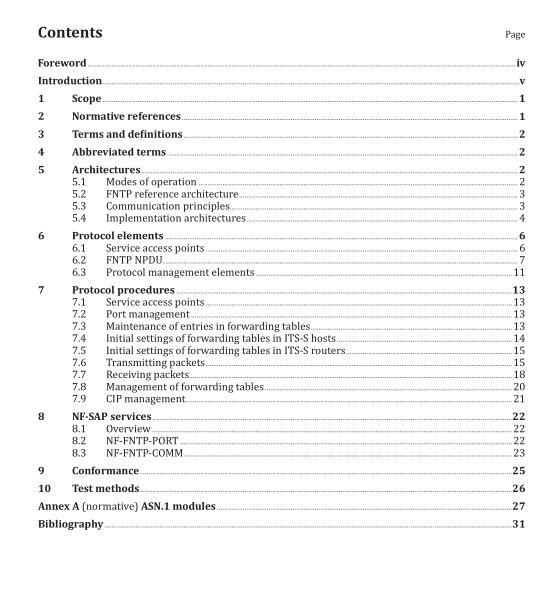ISO 29281-1:2013 pdf download.Intelligent transport systems — Communication access for land mobiles (CALM) — Non-IP networking — Part 1: Fast networking & transport layer protocol (FNTP)
This part of ISO 29281 specifies a protocol of the ITS-S networking and transport layer in support of efficient ad hoc single-hop communications with optional N-hop broadcast.
rhe protocol supports ITS station-internal forwarding of packets, i.e. between ITS-S routers and ITS-S hosts and vice versa. The protocol is named Fast Networking & Transport Protocol (FNTP).
2 Normative references
The following referenced documents are indispensable for the application of this document. For dated references, only the edition cited applies. For undated references, the latest edition of the referenced document (Including any amendments) applies.
ISO/IEC 8825-2. Information technology — ASPLJ encoding rules: Specification of Packed Encoding Rules (PERk? — Pcirt2
ISO 21217, IntellIgent transport systems — Communications access for land mobiles (CALM) — Architecture
ISO 21218, Intelligent transport systems — Communications access for land mobiles (CALM) — Access technology support
ISO 24102-1, Intelligent transport systems — Communications access for land mobiles (CALM) — ITS station management — Part I: Local management
ISO 24102-3, Intelligent transport systems Communications access for land mobiles (CALM) — fl’S station tnanagemenr — Part 3: Service access points
ISO 24102-4. intelligent transport systems — Communications access for land mobiles (CALM) — ITS st at ran management — Part 4: Station-internal management communications
ISO 24102-5, Intelligent transport systems — Communications access for land mobiles (CALM) — ITS station management — Part 5: Fast service advertisement protocol (F’SAPl
ETSI TS 102 985-1, Intelligent Transport Systems (ITS); Communications Access for Land Mobiles (CALM); Test specifications for non-IP networking (ISO 29281): Part I: Protocol implementation conformance ‘statement (PlC’S) proforma
ETSI TS 102 985-2, Intelligent Transport System.s (ITS): Communications Access for Land Mobiles (CALM), Test specqi canons for non-IP networking (ISO 29281); Part 2: Test suite structure & test purposes (TSS&TP)
ETSI IS 102 985-3, Intelligent Transport Systems (ITS): Communications Access for Land Mobiles (CALM); Test specifications for non-IP networking (ISO 29281); Part 3: Abstract test suite and partial PIXIT (ATS) specification
3 Terms and definitions
For the purposes of this document, the terms and definitions given in ISO 21217, ISO 24102-3, ISO 24102-4 and the following apply.
3.1 ITS-S port
source and/or destination “endpoint” for communications identified by an integer number
4 Abbreviated terms
FNTP Fast networking & transport protocol
ITS-SP ITS-S port
5 Architectures
5.1 Modes of operation
5.1.1 General context and purpose of FNTP
The “fast networking & transport layer protocol” (FNTP) specified in this part of ISO 29281 is designed as a protocol of the ITS-S networking and transport layer of the ITS station (ITS-S) architecture which recognizes the concepts of the bounded, secured and managed ITS-S; and supports the concept of ITS station communication units (ITS-SCU) to implement roles of an ITS-S in physical units specified (see ISO 21217, ISO 24102-1, ISO 24102-3 and ISO 24102-4).
FNTP is primarily designed to enable single-hop communication between peer ITS stations with
minimum protocol overhead, and supports optional features.
NOTE ISO 15628 legacy systems support specified in [2] makes use of FNTP.
FNTP supports any kind of ad hoc access technology, e.g. CALM M5, CALM IR. FNTP may be used to connect source and destination “endpoints” identified by “ITS-S port” (ITS-SP) numbers in peer ITS stations, where peer ITS stations are uniquely identified by a Link-ID (usually MAC address contained in it) of the access layer specified in ISO 21218. Consequently, FNTP is a port mapper protocol, usually located in the transport layer of the OSI model.
5.1.2 Basic mode of operation
The basic mode of operation is the simplest option of FNTP, which is just providing single-hop communications between instances of ITS stations without applying any of the options of FNTP.
5.1.3 Extended mode of operation
The extended mode of operation supports options of the FNTP, e.g.:
— ITS station-internal forwarding;
— secure communications;
— N-hop broadcast;
— LPP support;
— CIP management.
ITS station-internal forwarding is a special option referred to as “station-internal forwarding mode of operation”.
Other options may be added in a future revision of this part of ISO 29281.
5.2 FNTP reference architecture
Figure 1 illustrates the location of FNTP in the ITS station (ITS-S) specified in ISO 21217, and the communication relations with other protocol entities.ISO 29281-1 pdf download.ISO 29281-1-2013 pdf download
